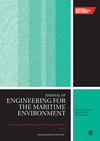基于多约束条件下自适应滑模控制的水下航行器输出容错控制
IF 1.5
4区 工程技术
Q3 ENGINEERING, MARINE
Proceedings of the Institution of Mechanical Engineers, Part M: Journal of Engineering for the Maritime Environment
Pub Date : 2024-06-20
DOI:10.1177/14750902241260104
引用次数: 0
摘要
为了提高水下航行器的稳定性,在设置多重约束的基础上,设计了基于自适应滑模控制的水下航行器输出容错控制方法。在对水下航行器及其推进器进行动态分析后,设定了输出尺寸约束、输入振幅约束和状态振幅约束。基于这三个约束条件,利用递归小脑神经网络在线识别水下航行器的时变和非线性未知故障,利用深度卷积神经网络检测水下航行器的已知故障。然后将纠错输出代码与支持向量机相结合,对检测到的故障进行分类。最后,基于自适应滑模控制实现了水下航行器的输出容错控制。实验表明,应用该方法后,由于递归小脑神经网络和深度卷积神经网络能及时估计故障信息的大小,滑模容错控制器能根据故障识别的结果重新调整控制器的输出,抵消故障对机器人的影响,使机器人能继续保持原有的稳定运行状态。即使推进器出现故障,该方法也能及时调整推进器的输出,并重建和恢复总控制输出,使实际输出推力非常接近预期值,实现水下航行器输出的容错控制。本文章由计算机程序翻译,如有差异,请以英文原文为准。
Output fault-tolerant control of underwater vehicle based on adaptive sliding mode control under multiple constraints
In order to improve the stability of the underwater vehicle, the output fault-tolerant control method of the underwater vehicle based on adaptive sliding mode control is designed on the basis of setting multiple constraints. After the dynamic analysis of the underwater vehicle and its thruster, the output dimension constraint, input amplitude constraint, and state amplitude constraint were set. Based on these three constraints, the recursive cerebellar neural network is used to identify the time-varying and nonlinear unknown faults in the underwater vehicle online, and a deep convolution neural network is used to detect the known faults of the underwater vehicle. The error correction output code is then combined with a support vector machine to classify the detected faults. Finally, the output fault-tolerant control of an underwater vehicle is realized based on adaptive sliding mode control. The experiment shows that after the application of this method, because the recursive cerebellar neural network and the deep convolution neural network can estimate the size of the fault information in time, the sliding mode fault-tolerant controller can readjust the output of the controller according to the result of the fault identification to offset the effect of the fault on the robot, so that the robot can continue to maintain the original stable operation state. Even if the thruster has faults, this method can adjust the output of the thruster in time and reconstruct and recover the total control output, so that the actual output thrust is very close to the expected value, to achieve fault-tolerant control of the underwater vehicle output.
求助全文
通过发布文献求助,成功后即可免费获取论文全文。
去求助
来源期刊

CiteScore
3.90
自引率
11.10%
发文量
77
审稿时长
>12 weeks
期刊介绍:
The Journal of Engineering for the Maritime Environment is concerned with the design, production and operation of engineering artefacts for the maritime environment. The journal straddles the traditional boundaries of naval architecture, marine engineering, offshore/ocean engineering, coastal engineering and port engineering.
 求助内容:
求助内容: 应助结果提醒方式:
应助结果提醒方式:


